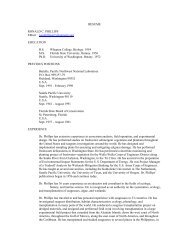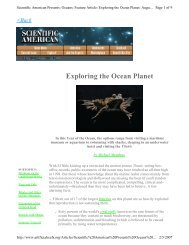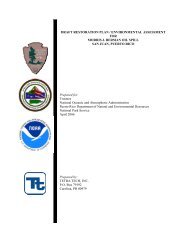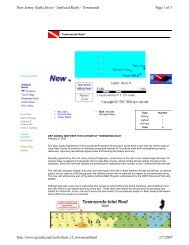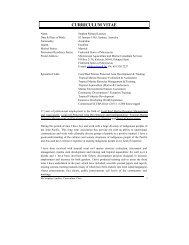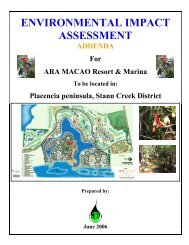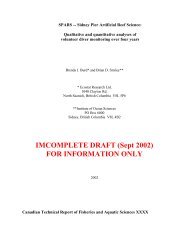Original Image - Reef Ball Foundation
Original Image - Reef Ball Foundation
Original Image - Reef Ball Foundation
You also want an ePaper? Increase the reach of your titles
YUMPU automatically turns print PDFs into web optimized ePapers that Google loves.
Environment - <strong>Reef</strong> <strong>Ball</strong> <strong>Foundation</strong> - Katherine Kirbo<br />
http://stage1.int.thetech.org/build/TechAward/masterprint.cfmid=4789<br />
AWARD CATEGORY: Environment<br />
APPLICANT CONTACT INFORMATION<br />
Name:<br />
Title:<br />
Organization:<br />
Project Name:<br />
Address:<br />
City:<br />
State:<br />
Katherine Kirbo<br />
Executive Director<br />
<strong>Reef</strong> <strong>Ball</strong> <strong>Foundation</strong><br />
<strong>Reef</strong> <strong>Ball</strong> <strong>Foundation</strong><br />
603 River Overlook Rd<br />
Woodstock<br />
GA<br />
Postal Code: 30188<br />
Country:<br />
United States<br />
Phone: 770-752-0202<br />
Fax: 770-360-1328<br />
Email:<br />
Url:<br />
Applicant Type:<br />
kathy@reefball.com<br />
http://www.reefball.org/<br />
Not-for-Profit Organization<br />
Would you be willing to have your project included in future University research efforts Yes<br />
APPLICATION QUESTIONS<br />
Project Profile:<br />
Please provide a 75 word profile of your technology as you would like it to appear<br />
on our website.<br />
The <strong>Reef</strong> <strong>Ball</strong> <strong>Foundation</strong> is an international environmental non-profit group. Our<br />
mission is to help restore our world’s ocean ecosystems and to emphasize and protect<br />
our natural reef systems through preservation, <strong>Reef</strong> <strong>Ball</strong> technology, innovative public<br />
education projects and community involvement. We work with governments,<br />
businesses, schools, research institutes, private individuals and community organizations.<br />
The <strong>Reef</strong> <strong>Ball</strong> <strong>Foundation</strong> has conducted projects in over 50 countries worldwide with<br />
partner diversity ranging from the Boy Scouts of America’s High Adventure program in<br />
Islamorada, Florida to the government of Sarawak’s marine sanctuary for sea turtles in<br />
Malaysia, to Instituto Ecoplan’s habitat restoration project in Brazil, and most recently a<br />
Tsunami restoration project in Thailand. <strong>Reef</strong> <strong>Ball</strong> has over 3,500 projects worldwide<br />
and has received extensive press coverage on CNN. ENN, the Discovery Channel,<br />
National Geographic, Weekly Reader, Popular Science, The Wall Street Journal,<br />
Mother Jones, Wired, Scientific American, various diving publications and in numerous<br />
newspapers throughout the world. www.reefball.org<br />
1 of 8 6/9/2005 3:41 PM
Environment - <strong>Reef</strong> <strong>Ball</strong> <strong>Foundation</strong> - Katherine Kirbo<br />
http://stage1.int.thetech.org/build/TechAward/masterprint.cfmid=4789<br />
Problem<br />
Identification:<br />
Description of<br />
Technology<br />
Application:<br />
What serious problem or challenge with broad significance does your use of<br />
technology address Explain your context and the existing conditions that you are<br />
trying to improve or rectify.<br />
The <strong>Reef</strong> <strong>Ball</strong> <strong>Foundation</strong> is addressing the decline of coral reef systems and the ocean<br />
ecosystems. Coral reefs are in decline all over the globe. Although they are located in<br />
the tropics their benefits are far reaching all across the world. The increase of human<br />
pressures on the reef systems over the last 50 years or so is putting a tremendous weight<br />
on the health of coral reefs. Dynamite fishing, run-off, pollution, global warming,<br />
overfishing are just a few of these pressures. Scientists report that 11 % of the world’s<br />
coral reefs have been lost and another 16% were damaged during 1998 with El Nino.<br />
Scientist estimate that another 32% of coral reefs will be lost in the next 30 years if we<br />
continue our present rate of destruction. Coral reefs are important because they provide<br />
a home for much of our marine environment and protect our coastlines. The severe<br />
decline of our coral reef systems will have disastrous consequences around the world.<br />
Without reefs, marine life will be threatened and we will have severe losses in<br />
biodiversity of species and in turn our fishing systems will be bankrupt. With the world<br />
overpopulation problems growing and with our fishing systems broke, this will make for<br />
a severe challenge in finding a way to feed the planet. Also, coral reefs are an important<br />
factor to the economy and tourism around the world. Coral reefs are a key component<br />
to our fisheries and tourism industries which many countries base their entire economy.<br />
Coral reefs also protect coastlines and the recent studies from the Boxing Day tsunami in<br />
Asia showed areas that had healthier reef systems had fewer losses of lives. Also, coral<br />
reefs are like the rainforest of the ocean and with their great plant and animal biodiversity<br />
many medicinal uses have been found within the reefs. Numerous useful drugs have been<br />
derived from species found in the reefs, such as a species of sponge that is used in<br />
cancer treatment, AZT. Other treatments derived from coral reefs are used for<br />
leukemia, ulcers, cardiovascular diseases, skin cancer, and sun tan lotion ingredients.<br />
Also, coral itself has been used for skin grafting materials. Coral reefs should be<br />
preserved, so that we may continue to do drug research on potential cures for diseases.<br />
Just like the rain forests, the coral reefs of the world may yield many new substances<br />
that can be used to better the human condition. Save reefs and the life they support so<br />
those discoveries can be made before they disappear. Because coral reefs play a vital<br />
role in our world and they have been severely threatened, The <strong>Reef</strong> <strong>Ball</strong> <strong>Foundation</strong> was<br />
formed to help preserve and restore coral reefs and our ocean ecosystems and provide<br />
unique educational projects and programs to raise the awareness of their importance.<br />
Fully describe the technology application. What technology is being used How is<br />
it being used Who is responsible Who is benefiting What processes or systems<br />
are in place to deliver this technology<br />
The <strong>Reef</strong> <strong>Ball</strong> <strong>Foundation</strong> stresses the importance of preserving our reef systems and<br />
preaches that it is wiser to take good care of a reef than to rebuild one. The loss of our<br />
natural systems, coupled with increased use, COMPELS US TO DO EVERYTHING<br />
WE CAN TO SAVE NATURAL REEFS. Even so, the natural reefs cannot rebuild<br />
themselves fast enough to meet human demands. A <strong>Reef</strong> <strong>Ball</strong> was designed to help<br />
2 of 8 6/9/2005 3:41 PM
Environment - <strong>Reef</strong> <strong>Ball</strong> <strong>Foundation</strong> - Katherine Kirbo<br />
http://stage1.int.thetech.org/build/TechAward/masterprint.cfmid=4789<br />
Explanation of<br />
Leading Edge or<br />
Breakthrough<br />
Technology:<br />
restore reefs. <strong>Reef</strong> <strong>Ball</strong> is a Designed Artificial <strong>Reef</strong> used to restore ailing coral reefs,<br />
marine habitat restoration, fishing reefs, diving reefs, beach protection, freshwater<br />
applications, mitigation, oyster reefs, research and educational applications, etc. A <strong>Reef</strong><br />
<strong>Ball</strong> is an artificial module made of a special concrete aggregates that mimics the<br />
appearance and function of the natural coral reef. <strong>Reef</strong> <strong>Ball</strong>s are hollow with openings<br />
and channels which create an ideal living environment for a variety of marine species.<br />
The concrete, with pH similar to sea water, assures compatibility with marine<br />
environments and enhance its attractiveness to colonizing invertebrates and plants. <strong>Reef</strong><br />
<strong>Ball</strong>s vary in composition, thickness, and size. Just as natural reefs vary, each module is<br />
different for various goals and applications. Varying surface pattern and textures also<br />
enhance marine life settlement. <strong>Reef</strong> <strong>Ball</strong>s are extremely stable and were designed to<br />
withstand movement and destruction during storms. <strong>Reef</strong> <strong>Ball</strong>s have remained stable in<br />
the highest rated storms including the tsunami in Asia. Natural reefs vary in size, shape<br />
and in the networks of holes through them. Artificial reefs function better when they<br />
mimic nature. The number, sizes and placements of holes can be altered for each<br />
individual unit to create a variety similar to that of a natural reef. The hollow interior<br />
space provides perfect housing and shelter for an abundant variety of marine life.<br />
Additionally, advanced coral transplantation techniques allow the addition of coral plugs<br />
to the reef ball’s surface to enable the quick initiation of hard and soft coral growth and<br />
allow coral damaged by storms, dredging, etc. to be saved and propagated. Aside from<br />
coral and marine habitat restoration, <strong>Reef</strong> <strong>Ball</strong>s are also used to oyster recovery in bays<br />
and estuaries, to protect beaches and are used for barrier reefs and breakwaters. This is<br />
an environmental friendly approach to beach restoration. Detailed technical information<br />
about the use and technology of <strong>Reef</strong> <strong>Ball</strong>s can be found on our website at<br />
www.reefball.org. The <strong>Reef</strong> <strong>Ball</strong> <strong>Foundation</strong> works with governments, businesses,<br />
schools, research institutes, private individuals and communication organizations. The<br />
<strong>Reef</strong> <strong>Ball</strong> <strong>Foundation</strong> has conducted projects in over 50 countries worldwide with<br />
partner diversity ranging from the Boy Scouts of America’s High Adventure program in<br />
Islamorada, Florida from the government of Sarawak’s marine sanctuary for sea turtles<br />
in Malaysia, to Instituto Ecoplan’s habitat restoration project in Brazil and Tsunami<br />
restoration in Thailand. The foundation has conducted on over 3500 projects<br />
worldwide. The foundation’s grant program, <strong>Reef</strong>s Around the World is a popular way<br />
to create a reef working with organizations providing <strong>Reef</strong> <strong>Ball</strong> molds or<br />
propagation/transplanting kits and training or an educational program. To qualify for the<br />
program, organizations must meet requirements and provide monitoring results for three<br />
years. We post monitoring and research studies on our website from all our projects.<br />
Why do you think that your use of technology is worthy of recognition Describe if<br />
it is a new technology or a new use of an existing technology. How can it be<br />
distinguished from existing uses Explain how it surpasses previous or current<br />
solutions.<br />
At the least, the work of the <strong>Reef</strong> <strong>Ball</strong> <strong>Foundation</strong> is worthy of recognition because its<br />
many projects bring to light the importance of our ocean ecosystems and why they are<br />
worth protecting and saving. Though a <strong>Reef</strong> <strong>Ball</strong> looks low tech, it is high tech in its<br />
design and an economical solution. We have created a way to construct them where<br />
3 of 8 6/9/2005 3:41 PM
Environment - <strong>Reef</strong> <strong>Ball</strong> <strong>Foundation</strong> - Katherine Kirbo<br />
http://stage1.int.thetech.org/build/TechAward/masterprint.cfmid=4789<br />
Evidence of<br />
Contribution<br />
Presentation of<br />
Measurable<br />
Results:<br />
they can easily be made and deployed in developing countries. We intentionally use<br />
construction tools and products they can be found anywhere and volunteers can easily<br />
learn the techniques. They also can be deployed without costly barges as they can be<br />
easily towed out and placed by divers through our inflatable buoy system. Artificial reefs<br />
originally got a bad name because it was mostly trash (materials of opportunity) being<br />
dumped in the oceans and rivers and they called it a reef. Like cars, refrigerators, tires,<br />
etc. This was more of a convenient way of dumping trash or a company getting rid of<br />
waste like tires. Tires became an example of this and tires were used as artificial reefs<br />
throughout the states. Eventually the states spent millions of dollars cleaning up tire<br />
fragments that washed up on beaches because they do not make good reefs and break<br />
apart. All of these items were never designed for restoring a reef or marine habitats. The<br />
materials can never be cleaned up well enough to not include toxic materials or they may<br />
shift during storms tearing up the ocean floor as they shift. Ships are a good example of<br />
this. <strong>Reef</strong> <strong>Ball</strong>s were designed to be stable and not shift in storms and have survived the<br />
highest rated storms including hurricanes and the latest tsunami. <strong>Reef</strong> <strong>Ball</strong>s materials are<br />
designed to be compatible with the ocean environment and are of a similar pH as salt<br />
water and designed to promote biodiversity.<br />
How do you know that your application of technology is making a contribution<br />
The <strong>Reef</strong> <strong>Ball</strong> <strong>Foundation</strong> requires through our grant program that all projects send in<br />
monitorings for three years and many of the projects are associated with universities or<br />
research institutes. We list many of these monitorings and studies on our website. Our<br />
website also promotes the exchange of information on coral reef studies. Most of our<br />
projects are ongoing and we keep up to date with monitorings. We have found that the<br />
projects are much more successful when there is community involvement in the project<br />
and we encourage working on partnerships within the community. This helps raise<br />
awareness of the project and if for example if it is a government project and the<br />
government changes guard the project could be forgotten, but if we have community<br />
partners there is a much greater chance the project will be ongoing. Our educational<br />
endeavors have twice won a national award for environmental excellence for the Sea<br />
World Bush Garden’s Environmental education awards.<br />
Describe the method(s) you are using to measure your results. How are you<br />
reporting your results and to whom To whom are you accountable<br />
Our grant program, <strong>Reef</strong>s Around the World, requires that projects send in monitorings<br />
for three years and most of these projects are associated with a research team or<br />
university or school and are generally accepted methods for monitorings of marine life.<br />
We post these findings on our website. We also have quality control standards that<br />
projects must maintain. Most governments have regulations we must meet for projects<br />
and we must get permits for projects for various departments, such as environmental<br />
resources, Army Core of Engineers, Fish and Wildlife, etc. Most governments also do<br />
studies of the projects and findings are available to us. Projects would not be allowed to<br />
continue or expand if results were favorable. We typically go to conferences to hear<br />
reports on our projects by universities and research institutes and the reports are<br />
generally sent to us and posted.<br />
4 of 8 6/9/2005 3:41 PM
Environment - <strong>Reef</strong> <strong>Ball</strong> <strong>Foundation</strong> - Katherine Kirbo<br />
http://stage1.int.thetech.org/build/TechAward/masterprint.cfmid=4789<br />
Description of<br />
Potential<br />
Negative<br />
or Unintended<br />
Consequences<br />
Discussion of<br />
Replication<br />
Potential:<br />
Discussion of<br />
Others<br />
Contribution:<br />
Describe any outcomes that may not be beneficial that you have considered. Who<br />
might consider your application problematic and why<br />
Perhaps some naturalists would object to restoring a reef as you should not interfere<br />
with Mother Nature as it is not natural. I believe in this case, if the human condition has<br />
helped to destroy it and there was a chance to revive it and help the environment and the<br />
human condition, we must do everything we can. Should we not give a liver transplant to<br />
someone who is ill and will have a meaningful life with the transplant just because it is not<br />
natural to have a transplant.<br />
Describe how your work might be a model for others to emulate. Could this<br />
application be put to use in other places or contexts<br />
I think our approach to doing projects as a business model could be vary helpful to<br />
other organizations working on similar projects for public benefit. The internet was a<br />
vital part of our success gaining volunteers and workers all around the globe. Also, a<br />
comparative approach could be a useful tool in trying to find a restorative measure for<br />
an environmental problem or medical problems, etc. Our initial group was not just<br />
scientists, but from all different professions that gave us a wide range of backgrounds for<br />
development. For example, artists wanted a reef ball to mimic the natural look of a reef,<br />
etc. This helped to develop our technology. Though they were original thought off to<br />
only restore coral, it expanded to breakwaters, beach protection, oyster recovery that<br />
helps forge out the water in bays and estuaries, coral transplants, mangroves, etc.<br />
Does this work draw upon the intellectual property or substantive contributions of<br />
others that should be acknowledged and appropriately reference<br />
The initial idea for the <strong>Reef</strong> <strong>Ball</strong> was by the <strong>Reef</strong> <strong>Ball</strong> <strong>Foundation</strong>’s president, Todd<br />
Barber and his father. Todd Barber holds the patent for the design. After having the<br />
initial idea, he enlisted the help of his college diving friends to implement the idea and<br />
later scientists and concrete experts,etc. From this hobby by diving friends, the<br />
foundation was born. The foundation’s success was developed through the work of the<br />
foundation’s board/staff who are mostly the foundation’s original volunteers and from<br />
that its success grew from the work of numerous dedicated world-wide volunteers. The<br />
key component to our success has been magically finding wonderful volunteers all<br />
across the world who deeply care about the environment and want to make a<br />
difference.<br />
REFERENCES<br />
Letter of Reference 1<br />
Referer Name Sir Nicholas Nuttall<br />
Referer Org. BREEF Bahmas <strong>Reef</strong> Enviromental Education <strong>Foundation</strong><br />
Referer Title Founder<br />
Referer Phone 242-362-6477<br />
Referer Email breef@coralwave.com<br />
5 of 8 6/9/2005 3:41 PM
Environment - <strong>Reef</strong> <strong>Ball</strong> <strong>Foundation</strong> - Katherine Kirbo<br />
http://stage1.int.thetech.org/build/TechAward/masterprint.cfmid=4789<br />
Complete<br />
Reference<br />
Yes<br />
Thursday, 05 May 2005 I have known and worked directly with <strong>Reef</strong>balls for over five<br />
years. This organisation bought two sets of <strong>Reef</strong>ball moulds and donated them to the<br />
Bahamian Field station on San Salvador, Bahamas, (now the Don Gerace Field Station)<br />
and to the Island School at Powell Point, Cape Eleuthera. I have made and launched a<br />
<strong>Reef</strong>ball myself and have observed their success in attracting both fish and young corals.<br />
By choosing an attractive natural shape for their product, that of a brain coral, <strong>Reef</strong>balls<br />
have benefited from an aeons old design that looks right for the job. From the start this<br />
attracted funds and inspired people who wanted to restore a reef or to build a natural<br />
breakwater. This common sense approach lies at the heart of their remarkable success<br />
around the world. A field of <strong>Reef</strong>balls of various sizes acts almost like a real reef in<br />
successfully dissipating wave energy. At first sight, a coral reef looks solid until closer<br />
inspection reveals that at every scale it is full of holes in which the fish can breed, shelter,<br />
or lie in ambush. <strong>Reef</strong>balls copied this structure by making their product hollow. This not<br />
only gives shelter like a reef, it makes the balls easy to cast, saves material, makes them<br />
easy to handle and float into position and keeps them stable once they are in position.<br />
By locating their production yards close to ready mix facilities whenever possible,<br />
<strong>Reef</strong>balls get a supply of material that the manufacturer would otherwise have to dump.<br />
This is a good example of waste management, recycling and energy conservation.<br />
<strong>Reef</strong>balls have designed an additive that neutralises the concrete making it more like a<br />
natural limestone substrate to attract the young coral planula. They are an art form, and<br />
far superior as artificial reefs than industrial discards such as cars, planes or warships. I<br />
support the award being given to the <strong>Reef</strong>ball organisation as suggested and not to one<br />
individual. I know both Kathy Kirbo and Todd Barber. It is typical that they would want<br />
the organisation they inspired to be recognised rather than themselves as individuals. It<br />
works around the world and it would be hard to single out someone individually. I have<br />
been working in marine conservation ever since I retired twelve years ago, and most<br />
admire those organisations whose output a sentient fish or coral would “recognise.”<br />
Some like ourselves get the laws changed so that fish are left in peace at breeding time.<br />
<strong>Reef</strong>balls provide fish with shelter year round and provide a base for coral growth to<br />
repair reefs damaged by nature or the works of man. They also benefit those fishermen<br />
who make their living from the coral seas and can provide a self renewing shelter for<br />
their homes and boats that are so often in peril from the full force of the open sea. As<br />
they are “at work” around the world in countless locations, I think that <strong>Reef</strong>balls would<br />
win the coral reef fish vote for your award over any other organisation for the direct<br />
benefit they provide.<br />
Nicholas Nuttall<br />
Sir Nicholas Nuttall Founder and Chairman Bahamas <strong>Reef</strong> Environment Educational<br />
foundation<br />
Referer Name<br />
William Izlar<br />
Letter of Reference 2<br />
6 of 8 6/9/2005 3:41 PM
Environment - <strong>Reef</strong> <strong>Ball</strong> <strong>Foundation</strong> - Katherine Kirbo<br />
http://stage1.int.thetech.org/build/TechAward/masterprint.cfmid=4789<br />
Referer Org.<br />
Referer Title<br />
Retired<br />
Advisor<br />
Referer Phone 404-873-0284, 404-307-9894<br />
Referer Email<br />
Complete<br />
whizlar@aol.com<br />
Yes<br />
This letter of recommendation is written and sent to you to support the application of the<br />
<strong>Reef</strong> <strong>Ball</strong> <strong>Foundation</strong> to receive a Tech Museum Award in the Environment category.<br />
I have been intimately involved with the <strong>Reef</strong> <strong>Ball</strong> <strong>Foundation</strong> for over 10 years. I am<br />
the Chairman of a private foundation, The Kuhrt <strong>Foundation</strong> – in no way related to the<br />
<strong>Reef</strong> <strong>Ball</strong> <strong>Foundation</strong>, its officers, or its members – located in Atlanta, Georgia that has<br />
helped sponsor the organization from its inception.<br />
The Kuhrt <strong>Foundation</strong> was the first official funder of the <strong>Reef</strong> <strong>Ball</strong> <strong>Foundation</strong>, and it is<br />
our only direct support for environmental projects. Through the years, The <strong>Reef</strong> <strong>Ball</strong><br />
<strong>Foundation</strong> has been extremely diligent in keeping us apprised of its projects and works<br />
by frequent reports, letters, notes and personal visits. In turn, The Kuhrt <strong>Foundation</strong> has<br />
been gratified by the wonderful environmental work done by the <strong>Reef</strong> <strong>Ball</strong> <strong>Foundation</strong><br />
during the time of our assistance to it.<br />
Our contact with the <strong>Foundation</strong> has been principally with Kathy Kirbo, Executive<br />
Director who has through the years manifested an inspirational selflessness in promoting<br />
the reef ball and collateral technology in helping to solve environmental problems literally<br />
around the world.<br />
Reference<br />
Kathy on a small budget and on a tiny income has given an incredible amount of herself<br />
to the <strong>Foundation</strong> and its work.<br />
I think this organization, <strong>Reef</strong> <strong>Ball</strong> <strong>Foundation</strong>, is particularly worthy of recognition.<br />
From its inception it has worked tirelessly to correct ecological damage and destruction.<br />
Kathy Kirbo and Todd Barber, President, travel the world and work hands-on in areas<br />
in need of reef and shoreline restoration.<br />
The <strong>Reef</strong> <strong>Ball</strong> <strong>Foundation</strong> has conducted projects in 50 countries including work done in<br />
East Asia, North, South and Central America and also in the Maldives off of the Indian<br />
sub-continent.<br />
At the present Kathy Kirbo and Todd Barber are working closely with the government<br />
of Thailand in the Phuket area to rebuild parts of the shoreline destroyed by the recent<br />
Tsunami. Both of them have visited and worked on site in the Phuket area and have<br />
organized another volunteer effort there and will travel, this fall, to Sri Lanka to work on<br />
Tsunami damage. They are doing this in the face of a number of other challenging<br />
projects in the Caribbean area that also need immediate attention.<br />
I feel that it is particularly appropriate that the <strong>Reef</strong> <strong>Ball</strong> <strong>Foundation</strong> itself be recognized.<br />
7 of 8 6/9/2005 3:41 PM
Environment - <strong>Reef</strong> <strong>Ball</strong> <strong>Foundation</strong> - Katherine Kirbo<br />
http://stage1.int.thetech.org/build/TechAward/masterprint.cfmid=4789<br />
I am not aware of any intellectual property or work by others—except Kathy Kirbo and<br />
Todd Barber—that should be recognized in conjunction with this nomination.<br />
I am confident that the technological contribution of the <strong>Reef</strong> <strong>Ball</strong> <strong>Foundation</strong> is the best<br />
in the field. Frankly, I know of no other institution doing such in depth and<br />
geographically wide ranging work in reef and shoreline restoration. This ecologically<br />
important work is benefiting humanity around the world.<br />
I can assure you that if Kathy Kirbo, Todd Barber and or the <strong>Foundation</strong> receive your<br />
award, the monies will be used for reef and shoreline environmental work.<br />
Please contact me at any time regarding the work of the <strong>Reef</strong> <strong>Ball</strong> <strong>Foundation</strong>. Our<br />
<strong>Foundation</strong> could not be more pleased with the work of the <strong>Reef</strong> <strong>Ball</strong> <strong>Foundation</strong> and<br />
its miraculous husbanding of its resources to dedicate them to the work of the<br />
<strong>Foundation</strong>.<br />
<strong>Reef</strong> areas and shorelines all around the world are better because of the work of the<br />
<strong>Reef</strong> <strong>Ball</strong> <strong>Foundation</strong>. We all need to continue to encourage its work.<br />
Sincerely yours,<br />
William H. Izlar, Jr., Chairman<br />
404-307-9894<br />
8 of 8 6/9/2005 3:41 PM



